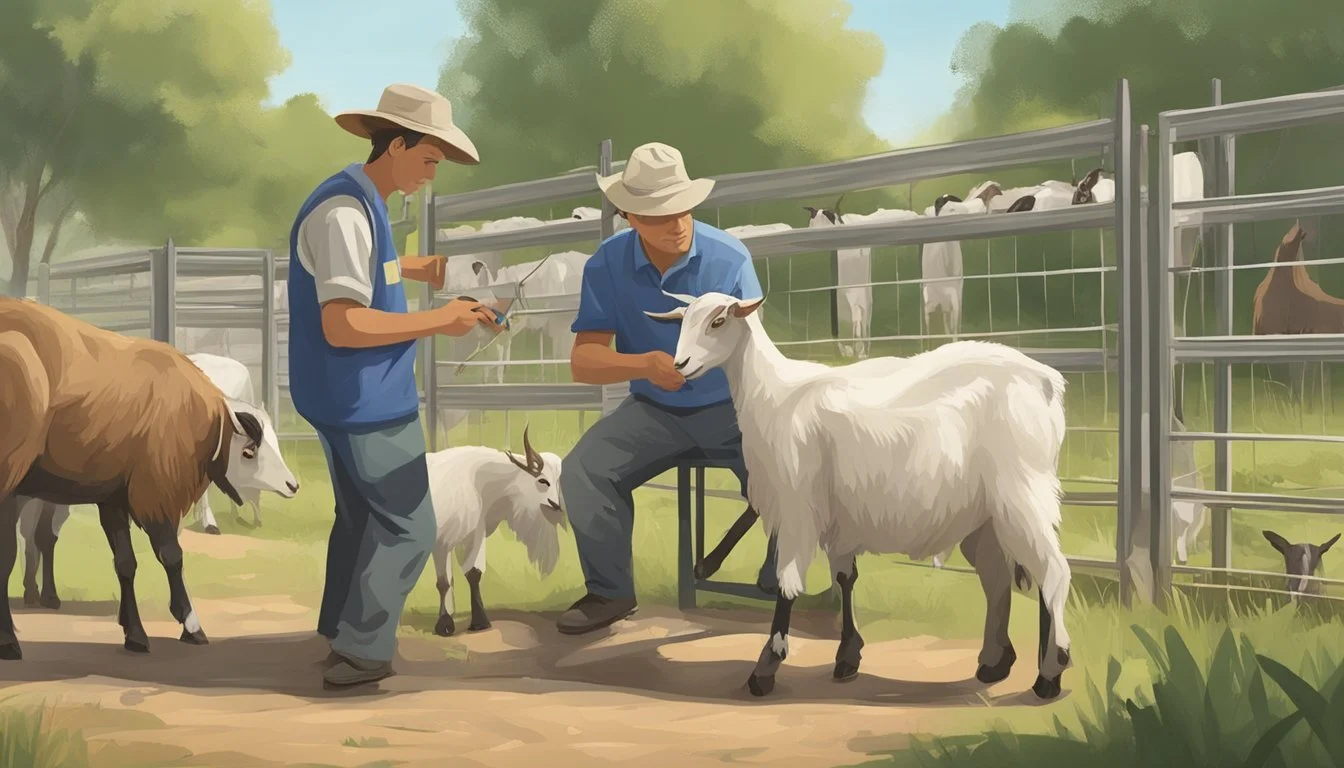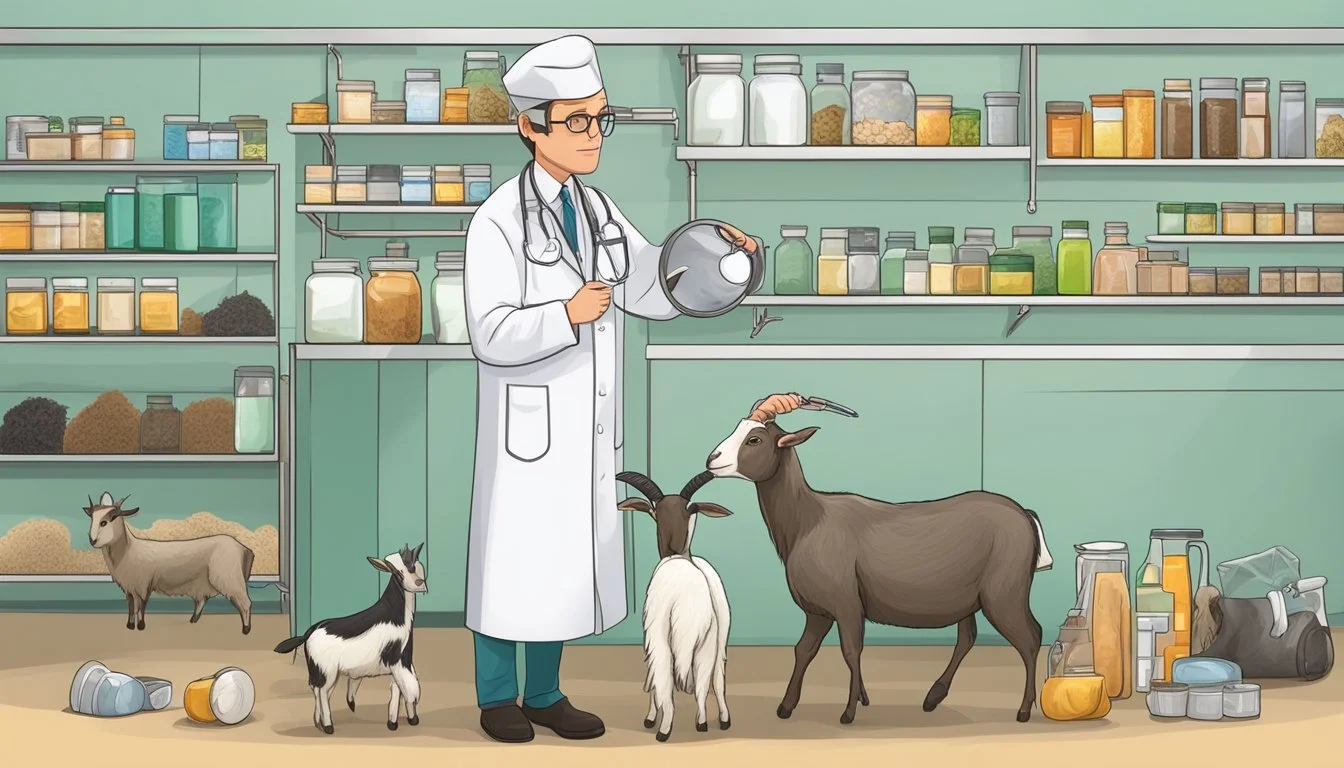How Often Should Goats Be Dewormed
Optimal Frequency and Effective Products
Maintaining the health of goats is critical for any herd owner, and a key component of this is effective deworming. Deworming goats is necessary to manage parasites that can otherwise hinder their growth, milk production, and overall well-being. However, the frequency of deworming and the choice of products vary greatly and should be informed by a herd's specific needs and local veterinary advice.
Common indicators of parasitic infection in goats include weight loss, anemia, diarrhea, and a poor coat condition, yet preventive deworming is also a widely adopted strategy. This approach to goat deworming helps prevent the establishment of high parasite loads which, if left unchecked, can lead to significant health issues and even mortality.
Selecting the right goat dewormer is just as important as the schedule followed. A range of products is available, and their usage is influenced by the types of parasites prevalent in the area, the resistance developed by worms to certain treatments, and the withdrawal period recommended for milk or meat following treatment. It's always best for goat owners to consult with their local veterinarians to tailor a deworming program that is safe, effective, and well-suited to their specific herd requirements.
Understanding Deworming in Goats
Deworming in goats is a critical health management practice aimed at controlling internal parasites, which can cause significant health issues such as anemia, bottle jaw, weight loss, and diminished appetite, ultimately affecting a goat's body condition. Resistance to dewormers has become a growing concern. As parasites evolve, instances of dewormer resistance have heightened, necessitating careful management and proper use of anthelmintics.
A prudent approach to deworming involves the strategic administration of treatments based on need and effectiveness. This can be assessed by conducting a fecal egg count (FEC), which helps determine the burden of parasites and the need for treatment. Here are critical steps in managing the deworming process:
Initial Examination: Look for symptoms of parasite infestation such as lethargy, anemia, bottle jaw, or poor body condition.
Fecal Egg Count (FEC): Before deworming, conduct a baseline FEC to assess the parasite load.
After deworming, a follow-up FEC is crucial to evaluate the efficacy of the deworming product used. If the FEC reduction is less than 95%, it may indicate potential parasite resistance and the need to switch products.
Anthelmintics: The choice of dewormer is critical. Options include broad-spectrum anthelmintics, which should be used as per veterinary guidelines to ensure they target the specific parasites affecting the herd. Overuse or incorrect dosing can exacerbate resistance issues.
Regular monitoring for signs of poor health and periodic FECs are part of a responsible deworming protocol, alongside proper dosing and herd management practices, to mitigate resistance and protect the health of the goat herd.
Identifying Common Goat Parasites
Effective goat health management includes understanding the parasites that commonly afflict goats. Recognizing the signs and lifecycle of each can help farmers tackle the worm burden effectively.
Barber Pole Worms
Haemonchus contortus, commonly known as the Barber Pole Worm, is a notorious parasite in goats, causing a condition known as haemonchosis. They affect the abomasum of the goat, leading to severe anemia, bottle jaw, and potentially, death. These worms are easily identified by their distinctive red and white coloring, which resembles a barber pole.
Stomach Worms
Stomach worms, or Trichostrongylus, are another group of parasites that reside primarily in the goats' gastrointestinal tract. These parasites can cause damage to the lining of the gut, leading to diarrhea and weight loss. During periods of "worm bloom," they can quickly become a substantial problem, multiplying and increasing the worm burden.
Tapeworms
Tapeworms make their home in a goat's intestines and are segmented flatworms that can be seen with the naked eye in feces. While often less dangerous than other parasites, a significant tapeworm burden can impact a goat's health by causing weight loss and nutritional deficiencies.
Lung Worms
Lung worms settle in the respiratory tract of goats, leading to coughing and respiratory distress. These pests can complicate the diagnosis of other respiratory illnesses due to the similarity in symptoms. A heavy lung worm infestation can cause serious harm and even mortality, especially in young or immunocompromised animals.
Liver Flukes
The Liver Fluke, Fasciola hepatica, is a flatworm that causes damage to a goat's liver. This can lead to reduced productivity, weight loss, and in severe cases, liver failure. Identifying and treating liver flukes is critical as they can also be a health concern for humans who consume contaminated meat or liver.
Deworming Frequency and Timing
Goat owners should establish a deworming schedule based on the specific needs of their herd. Factors influencing the frequency of deworming include the wetness or dryness of the area, goats' population density, parturition time, and overall health status of the goats.
Wetter regions often require more frequent deworming due to the higher survival rate of parasites in moist conditions.
Higher population density in pens and pastures can lead to increased worm loads, necessitating more frequent treatments.
A strategic approach involves conducting a Fecal Egg Count Reduction Test (FECRT) to tailor deworming protocols effectively. This test helps in:
Assessing the effectiveness of the dewormer being used.
Determining the current worm burden within the herd.
Based on the FECRT, if a significant reduction in egg count is not observed, it suggests resistance and calls for an alternative deworming strategy. Moreover, examining the body condition score can signal the need for deworming, as poor condition may indicate high worm loads.
For deworming goats after kidding, it is advised to treat the doe within 24 hours due to the potential for a worm bloom triggered by the stress of parturition. Here are some recommended products and their dosages:
Product: Safe-Guard/Panacur Suspension (10% or 100 mg/ml)
Dosage Recommendation: 10 mg/kg
Withdrawal Period: 16 days for meat, 4 days for milk
Ultimately, the timing of deworming should aim to minimize the parasite load while ensuring the well-being of the goats.
Choosing the Right Dewormer
Selecting an effective dewormer involves understanding the chemical classes of available products, their efficacy against specific parasites, and the various application methods. Each class has different active ingredients that target parasites, and the choice of dewormer will depend on the particular needs of the goats and the level of parasite resistance encountered.
Chemical Classes of Dewormers
There are major chemical classes of dewormers used in goats, including benzimidazoles, such as fenbendazole and albendazole; macrocyclic lactones, like ivermectin, moxidectin, and morantel tartrate; and imidazothiazoles, with common representatives such as levamisole. Among benzimidazoles, products such as Valbazen and SafeGuard are widely used. Prohibit and Rumatel are examples of imidazothiazoles, while macrocyclic lactones include products like Ivomec.
Considering Product Efficacy
When considering product efficacy, one must keep in mind the prevalence of resistance within each class of anthelmintic. Resistance can reduce a product's effectiveness. It's important to work with a veterinarian to conduct fecal egg count tests and determine which dewormers remain effective for the herd. The anthelmintic must target the specific parasites present, and periodic assessments for efficacy and signs of toxicity should also be part of the deworming strategy.
Understanding Different Applications
Dewormers come in various forms, including oral applications, injectables, and pour-on solutions. Oral route dewormers, like solid dewormers and liquid suspensions, are commonly used due to ease of administration and direct impact on gut parasites. Injectables and pour-on dewormers are alternatives that can offer different spectrums of control. The choice of application method should consider the specific parasite challenges, the ease of administration for the handler, and the stress level on the goats.
Dosage and Administration
When deworming goats, it is crucial to administer the correct dosage to ensure efficacy and prevent resistance. Dosages vary depending on the product used and the particular needs of the goat—factors like body condition, age, and extra-label use should be taken into account. A general guideline is to follow the manufacturer’s recommended dosage, but note that goats often require a higher dose than what's listed due to their unique metabolism.
Example Dosages for Common Dewormers:
Safe-Guard/Panacur Suspension (10% or 100 mg/ml): For goats, a dosage of 10 mg/kg is recommended, despite the label dose being 5 mg/kg.
Ivermectin: Typically used at a dose of 0.2 mg/kg.
It is advisable to consult with a veterinarian to determine the appropriate dosage, especially since most dewormers are not FDA-approved for use in goats and require extra-label use.
Administration should be performed carefully to avoid stress, which can impact the animal's mucous membranes and overall health. Body condition scoring prior to treatment can also guide the dewormer administration process, ensuring that each goat receives a dose that reflects its weight and health status.
Before administering any treatment, inspect the goat's mucous membranes, which can offer insights into their health and the necessity for deworming. FAMACHA scoring is a useful tool to check for signs of anemia, a common symptom of parasite infestation, by looking at the color of the goat's lower eyelid.
Finally, record keeping of dosages and treatments is essential for managing the health of the herd and adhering to withdrawal times for milk and meat, as specified by the dewormer used.
Monitoring and Managing Parasite Resistance
When it comes to managing goat herds, dewormer resistance is a critical issue that requires careful attention. Over time, parasites can develop resistance to deworming products, making them less effective and posing significant challenges to animal health. To ensure effective parasite control, it's essential to monitor the herd's response to deworming agents and apply strategies that reduce the risk of resistance.
Regular Fecal Egg Count Testing (FEC):
A core component in monitoring for resistance is performing fecal egg count tests. These tests determine the parasite's burden before and after deworming to assess the dewormer's efficacy. A reduction in egg count by less than 95% can indicate possible resistance.
Deworming Practices:
Selective treatments should be prioritized over blanket deworming, treating only those animals that show signs of infestation.
Rotating dewormers with different modes of action can help prevent resistance build-up.
Integrating non-chemical control methods, such as proper grazing management, can reduce dewormer reliance.
Implementation of Resistance Management Plans: Effective plans typically include:
Education on recognizing early signs of parasite resistance.
Strategic deworming schedules based on climate, herd size, and pasture management.
Record-keeping of deworming dates, products used, and post-deworming FEC results.
For more detailed insights, the articles "Effective methods and techniques for deworming goats" and "Vaccinating and deworming goats" serve as comprehensive resources.
Managing parasite resistance is an ongoing process and requires a proactive approach to ensure the long-term health and productivity of goat herds.
Withdrawal Periods and Milk Safety
When administering dewormers to goats, it is critical to observe withdrawal periods for both meat and milk to ensure the safety of the products for human consumption. A withdrawal period is the time that must pass after deworming before milk or meat can be safely consumed.
Safe-Guard/Panacur Suspension is a commonly used dewormer for goats. It has a recommended dose of 10 mg/kg, and the withdrawal times are as follows:
Meat: 16 days
Milk: 4 days
For every additional day the drug is administrated, an extra day should be added to milk withdrawal. For example, if a goat receives the dewormer for two days in a row, the milk withdrawal period should be extended to 5 days post the second dose.
FARAD (Food Animal Residue Avoidance Databank) recommends these periods be strictly adhered to, to avoid drug residue in food products. Farmers and goat owners should always keep detailed records, including deworming dates, dewormer types, and withdrawal periods.
Below is a chart highlighting withdrawal times for some deworming products:
Dewormer: Safe-Guard (Fenbendazole)
Meat Withdrawal: 16 days
Milk Withdrawal: 4 days +
Dewormer: Ivermectin
Meat Withdrawal: Not established for milk
Milk Withdrawal: Consult your vet
An essential factor to note is that the withdrawal time in milk has not been established for some products such as Ivermectin. Producers should consult with a veterinarian for the most accurate and updated information regarding drug use in lactating goats.
Implementing a clear schedule and following withdrawal guidelines helps in maintaining the health of the herd and the safety of consumers.
Deworming Pregnant and Nursing Does
When managing goat herds, special attention should be paid to the deworming protocols, especially for pregnant does and nursing does.
Pregnant Does: It is crucial to administer dewormers to pregnant goats to prevent the transmission of parasites to the newborns. A strategic time for this is at least six weeks before the kidding date. Certain dewormers are deemed safe for use during pregnancy, such as Cydectin (sheep drench) and Ivermectin (available in forms such as horse paste, injectable, and sheep drench).
Nursing Does: Care should be taken when choosing a deworming product for nursing does, as medication can be passed to the kids through milk. Products like Safe-Guard/Panacur suspension are often recommended. Dosage and withdrawal times must be carefully adhered to for the safety of the kids and milk consumers.
When administering dewormers, the goat's ease and the handler's confidence are paramount to avoid stress and ensure effective treatment. Incorporating essential oils, like wild orange, may enhance effectiveness against parasites within an integrated pest management approach.
Effective Deworming Protocols Include:
Lifecycle Stage: Pregnant Does
Dewormer Options: Cydectin, Ivermectin
Considerations: Administer ≥6 weeks before kidding
Lifecycle Stage: Nursing Does
Dewormer Options: Safe-Guard/Panacur
Considerations: Observe milk withdrawal times
Finally, regular fecal egg count tests can help tailor deworming schedules more accurately to individual needs within a herd. Always consult a veterinarian for the most current and suitable deworming strategy for pregnant and nursing does.
Best Practices for Pasture Management
Effective pasture management is integral to maintaining the health of a goat herd. By implementing strategic grazing practices, farmers can significantly reduce the parasite load in their animals.
Reducing Parasite Loads Through Grazing
Rotational Grazing: Implementing a rotational grazing system can help in breaking the life cycle of parasites. By moving goats to fresh pastures regularly, the likelihood of goats ingesting parasite larvae decreases. According to Goats - Extension, it's important to allow pastures to rest as the worm eggs and larvae need time to die off.
Grazing Height: Parasite larvae tend to be present in higher numbers closer to the ground. Ensuring that goats graze at a height of at least 4 inches can minimize their exposure to these parasites.
Multi-Species Grazing: Having other livestock species graze the same pasture either before or after goats can help reduce the parasite load as many parasites are host-specific.
Pasture Resting: Parasites can't survive indefinitely without a host. Leaving a pasture empty for a season or more allows for natural die-off of parasites, enhancing pasture health for future grazing.
Monitoring Pasture Load: Regularly monitoring the grass and parasite levels in fecal samples can guide farmers in making informed decisions about grazing management. This helps in determining the right time to move goats to a new pasture.
It's important to know that good nutrition plays a pivotal role in enabling goats to mount an effective immune response against gastrointestinal parasites. Ensuring that the high nutritional needs are met by providing goats with the best quality pastures can be a cornerstone in effective grazing management.
Alternative Control Strategies
In managing the health of goat herds, alternative control strategies for parasites can play a crucial role beyond typical deworming protocols. These methods aim to proactively manage risks and minimize the reliance on chemical wormers, thereby reducing the chance of drug resistance.
Coccidiosis Management
Coccidiosis is a disease caused by the protozoan parasites of the genus Eimeria. Effective management involves ensuring clean and dry bedding to reduce the risk of infection, as high moisture levels promote the lifecycle of coccidia. In addition, rotating pastures and providing adequate space for goats can help limit the spread of the disease within the herd.
Preventative measures: Regular cleaning and disinfecting of pens and water troughs aids in reducing infection pressure on animals.
Early intervention: At the first signs of coccidiosis, such as diarrhea, it is imperative to begin treatment promptly to prevent severe health issues or spread to other members of the herd.
Using Medicated Feed
Medicated feed can be utilized as a preventative measure against internal parasites, including coccidiosis. The feed contains medication that helps in controlling the development of coccidia within the goats' intestines before they cause disease.
Specific medicated feed: Feeds formulated with coccidiostats can prevent clinical coccidiosis, especially in young kids who are most susceptible.
FDA regulations: It is important to adhere to the Food and Drug Administration's (FDA) guidelines when using medicated feeds to ensure proper dosage and withdrawal times, thereby maintaining food safety standards.
Working with Veterinarians
When addressing the question of how often goats should be dewormed and what products to use, consulting with a veterinarian is essential. A veterinarian can provide a diagnosis of the specific parasitic issues present through fecal sample analysis, ensuring that treatment is targeted and effective.
Initial Assessment
Fecal Examination: Vets perform fecal egg counts to quantify parasite load.
Health Evaluation: General health checks help determine if the goats are at risk.
Developing a Deworming Schedule
Veterinarians advise on deworming frequency based on:
Parasite type and load
Farm management practices
Local climate and environmental conditions
Deworming Products and Protocols
Working closely with a veterinarian enables goat owners to choose deworming products wisely. It is recommended to use a product with an appropriate withdrawal period and at a recommended dosage for goats, as recommended by Cornell University College of Veterinary Medicine.
Integrated Parasite Management (IPM)
Veterinarians often support IPM strategies, including:
Regular fecal sample checks
Administration of dewormers based on fecal egg counts
Alternative methods such as pasture rotation and nutritional support
They ensure that the approach to parasite control is comprehensive, sustainable, and suited to each individual herd's needs.
Conclusion
Deworming goats is a critical aspect of their health management. Regular fecal egg count tests are invaluable for determining the right deworming schedule. They typically need a deworming treatment when they show signs of parasite load, such as anemia indicated by pale mucous membranes. The frequency of treatments varies with environmental conditions and herd health status.
There are several effective goat dewormer products available. Among them, the top choices include Safeguard, Valbazen, and Ivomec, which are known for their efficacy. Yet, the selection of a dewormer should always be based on the specific parasites present and the advice of a veterinary professional.
Natural deworming methods, while less conventional, can be considered for those seeking alternative approaches. These methods emphasize preventive care through good pasture management and bolstering herd immunity.
In short, tailoring deworming strategies to individual herds and staying informed on the latest deworming practices are imperative. Doing so ensures the wellbeing of goats and sustains the productivity of the herd.







